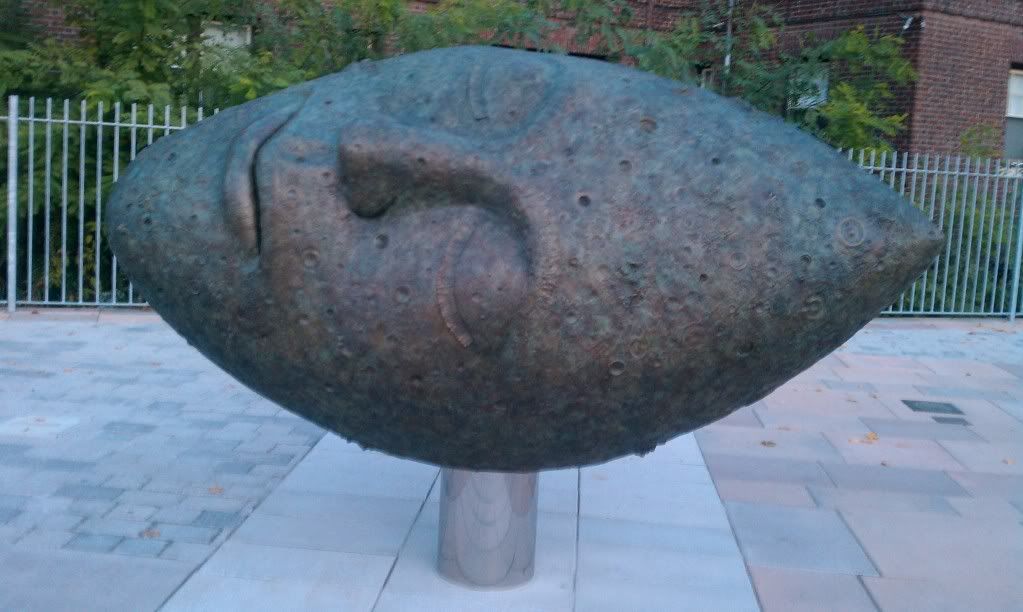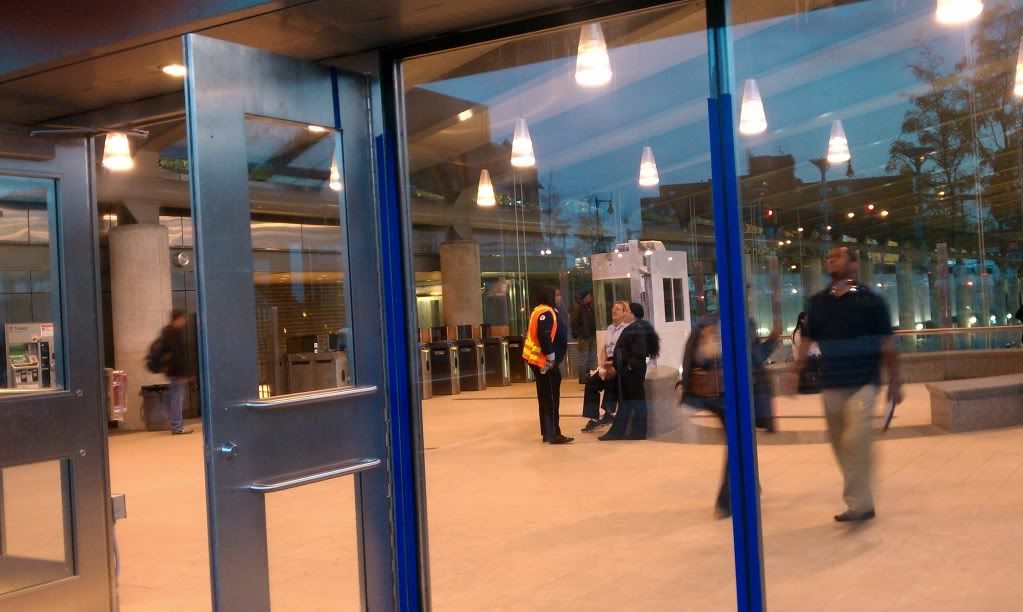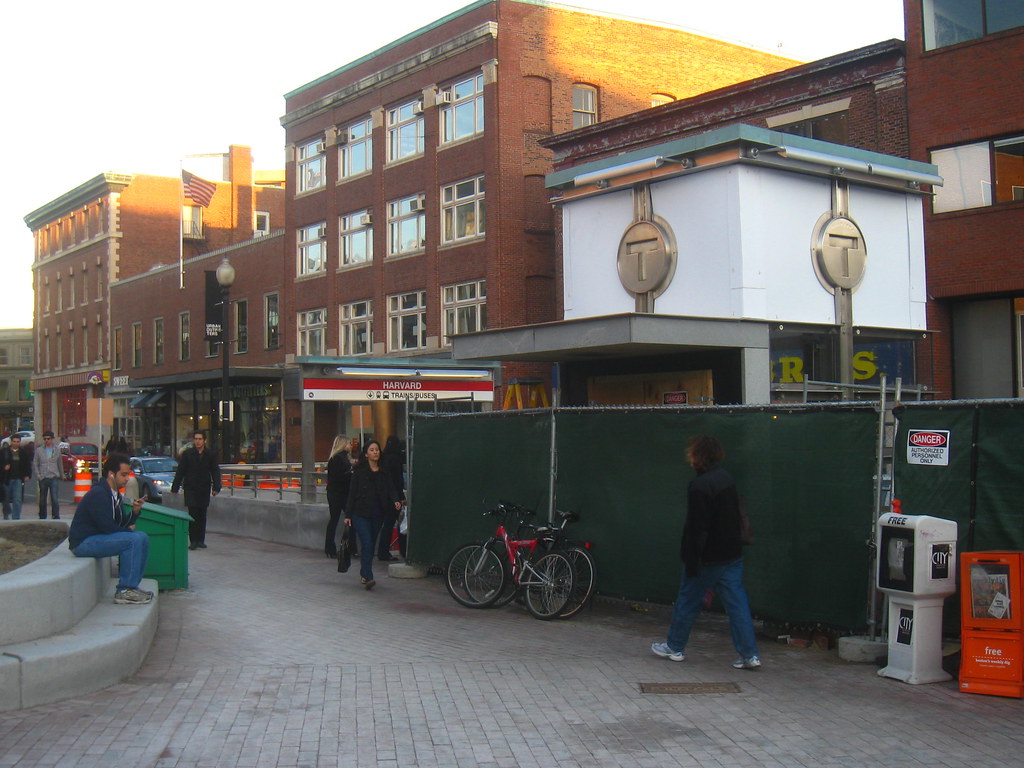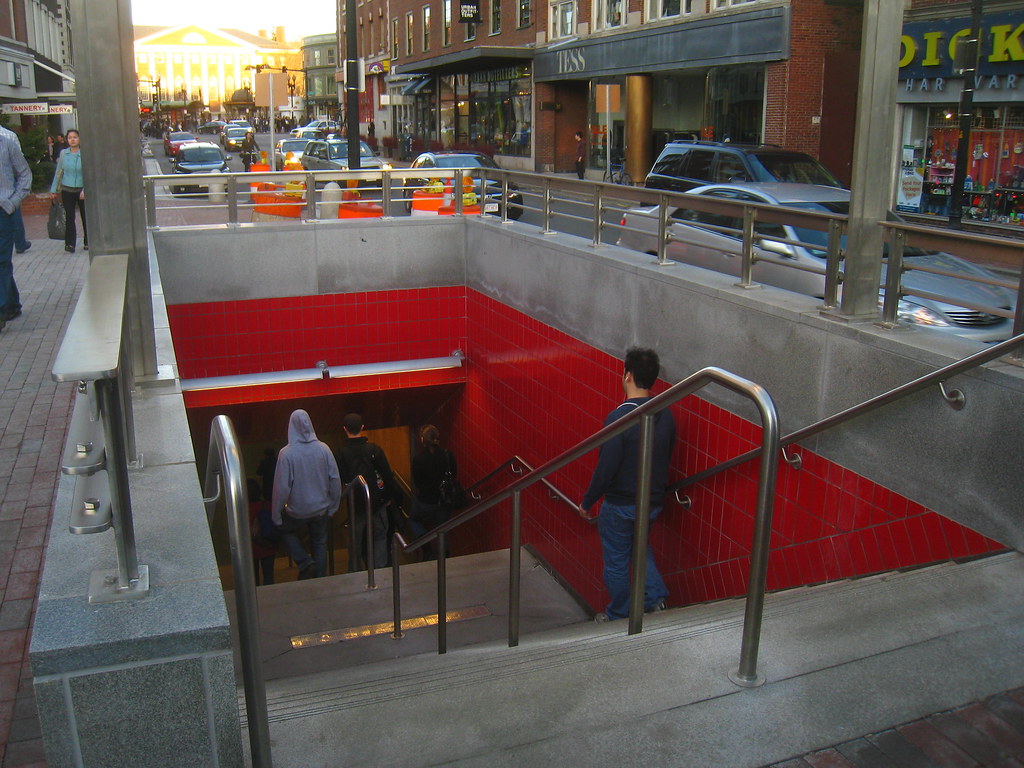found5dollar
Senior Member
- Joined
- Aug 27, 2007
- Messages
- 1,149
- Reaction score
- 404
Re: T construction news
http://www.boston.com/news/local/ma...e_remaking_of_a_grand_entrance/?p1=News_links
The Boston Globe
The remaking of a grand entrance
Long neglected, Copley Square subway portal gets a return to glory
In a world of functional but mundane MBTA entrances, the portal for inbound travelers at Copley Square is one of a kind: a filigreed framework of flowers and curlicues in cast iron, at once classically inspired and reminiscent of the Art Nouveau kiosks that distinguish the Metro in Paris.
The civic leaders who commissioned the covered entrance 99 years ago wanted to enhance the grandeur of the Boston Public Library behind it, not mar it with a run-of-the-mill subway entrance. But with time and neglect, the fine details became obscured by rust, thick layers of paint, and assorted graffiti; transients were sleeping on the roof. The structure, bowed and buckling, was at risk of collapse.
But now, after more than two years of painstaking repairs and reconstruction, the Copley Station inbound head house ? as subway en trances are known ? has been restored.
A crew from the same Easton blacksmith shop that revived the gates enclosing Harvard Yard and the ornamentation around the State House is in the process of reinstalling it on the Boylston Street sidewalk near Dartmouth Street.
The restoration, costing a little under $1.9 million, is a mere line item on the books of a roughly $50 million modernization project intended to make the Green Line stations at Arlington and Copley accessible to people with disabilities. That federally mandated work was slowed by a series of expensive lawsuits and unexpected problems, including accidental damage to two protected National Historic Landmarks nearby: a cracked stone bench on the library?s facade, and a foundation-to-roofline fissure through the stone wall of Old South Church.
The protracted project has rendered one of Boston?s most prominent intersections a cluttered construction zone for five years. With the work finally coming to a close this fall, the resurrection of the historic Copley head house ? a ?belle-?poque confection,?? as one local history book dubbed it ? provides a sweet form of punctuation.
?It?s glorious,?? said the Rev. Nancy S. Taylor, senior minister of the Old South Church, an admirer of the entrance through it all.
Even in decline, with some of the windows painted over and some of the pieces broken off, MBTA officials recognized the Copley entrance as an aesthetic and historic resource that should be saved, said Andrew D. Brennan, the T?s director of environmental affairs. But they could not muster the money to pay for restoration until they were able to combine it with the larger disability-access project ? and by then they feared the structure might be too far gone to be rehabilitated.
DeAngelis Iron Work of Easton, which specializes in sensitive historical projects, was hired to tag, catalog, and dismantle each piece of decorative ironwork ? roughly 1,000 altogether, some smaller than a saucer ? making up the 16-by-20-foot head house.Then DeAngelis carted the fragile pieces to its workshop, cleaning and sorting to determine which ones were salvageable.
In the meantime, contractors in Boston, working to add multiple elevators and other features to the station, rigged a plywood shelter over the exposed stairs so the station?s inbound entrance could remain open.
In Easton, DeAngelis used a blend of old-fashioned blacksmith techniques and sophisticated software to remove decades of paint and corrosion, create a model for reconstruction, and weld and mend those pieces that could be saved. To fill in gaps, the firm employed Rhode Island?s Cumberland Foundry to cast precise replica parts, said Harry Dodakian, a DeAngelis principal and senior project manager.
In the end, about 90 percent of the original external and interior ironwork was preserved.
?Ninety percent for us on this project, we think, is just a tremendous milestone, given the number of pieces,?? Brennan said. ?There was some concern that they would just crumble as you were taking them apart.??
The firm?s work revealed some surprises. For one, DeAngelis discovered that the blackened lanterns atop the corners of the head house were actually bronze, not iron, and they will once again gleam.
The crew also found that the head house?s decorative iron shell was erected around a hidden steel skeleton so old (one section was stamped CARNEGIE) and so corroded that it had given way, forcing the ornamental sections to bear the load. DeAngelis designed and built a new steel frame, galvanized to last longer, and in compliance with current codes to withstand snow, wind, and earthquakes.
That skeleton came in whole on a flatbed truck in the quiet of the night a month ago, and workers since have been fastening the decorative ironwork around it, which they expect to complete in early October, Dodakian said. That month will mark the 96th anniversary of the opening of the Boylston Street Subway ? now part of the MBTA?s Green Line ? which came three years after the Legislature authorized that line, in 1911, to alleviate trolley traffic and expand Boston?s nascent subway system.
The special inbound head house commissioned at Copley was designed by the Boston architecture firm Fox and Gale, in consultation with library officials, and built by HeclaWinslow Co., a firm whose Brooklyn workshop also produced the iron and bronze adorning many of New York?s landmarks, including Grand Central Station and the Dakota apartment building.
It no doubt helped Hecla?s case that its crews had fashioned the exterior metalwork for the Boston Public Library two decades earlier, but the firm also submitted the lowest of four bids that year: $9,890.
The ironwork echoes that of the library?s facade, and the canopy arch over the stairway to the inbound platform includes a seal with an open book. Shortly after completion, a proud Hecla-Winslow selected that Copley entrance, among its many projects, to showcase its work in a 1915 ad in Architecture magazine.
Daniel J. Beaulieu, a project manager for the T, keeps in his back pocket a copy of a photo of the head house under construction at the Hecla-Winslow factory, as a kind of good luck charm, and plans to do so until major work at Copley is finished this fall. In the spring, the T?s contractor and the contractor?s insurance company will pay to repair the damage at Old South Church.
Beaulieu sometimes shows the photo to passersby who inquire about the temporary plywood entrance and the work in progress. Earlier this week, standing before a nearly completed elevator shaft on the outbound side, Beaulieu again extracted the creased photo from his pocket. He admired the ironwork in its initial splendor, as did the others joining him on a site visit.
?It?s so cool,?? Brennan said, eyeing the photo as the real thing took shape behind him. ?It?s a beautiful structure.??
http://www.boston.com/news/local/ma...e_remaking_of_a_grand_entrance/?p1=News_links
The Boston Globe
The remaking of a grand entrance
Long neglected, Copley Square subway portal gets a return to glory
In a world of functional but mundane MBTA entrances, the portal for inbound travelers at Copley Square is one of a kind: a filigreed framework of flowers and curlicues in cast iron, at once classically inspired and reminiscent of the Art Nouveau kiosks that distinguish the Metro in Paris.
The civic leaders who commissioned the covered entrance 99 years ago wanted to enhance the grandeur of the Boston Public Library behind it, not mar it with a run-of-the-mill subway entrance. But with time and neglect, the fine details became obscured by rust, thick layers of paint, and assorted graffiti; transients were sleeping on the roof. The structure, bowed and buckling, was at risk of collapse.
But now, after more than two years of painstaking repairs and reconstruction, the Copley Station inbound head house ? as subway en trances are known ? has been restored.
A crew from the same Easton blacksmith shop that revived the gates enclosing Harvard Yard and the ornamentation around the State House is in the process of reinstalling it on the Boylston Street sidewalk near Dartmouth Street.
The restoration, costing a little under $1.9 million, is a mere line item on the books of a roughly $50 million modernization project intended to make the Green Line stations at Arlington and Copley accessible to people with disabilities. That federally mandated work was slowed by a series of expensive lawsuits and unexpected problems, including accidental damage to two protected National Historic Landmarks nearby: a cracked stone bench on the library?s facade, and a foundation-to-roofline fissure through the stone wall of Old South Church.
The protracted project has rendered one of Boston?s most prominent intersections a cluttered construction zone for five years. With the work finally coming to a close this fall, the resurrection of the historic Copley head house ? a ?belle-?poque confection,?? as one local history book dubbed it ? provides a sweet form of punctuation.
?It?s glorious,?? said the Rev. Nancy S. Taylor, senior minister of the Old South Church, an admirer of the entrance through it all.
Even in decline, with some of the windows painted over and some of the pieces broken off, MBTA officials recognized the Copley entrance as an aesthetic and historic resource that should be saved, said Andrew D. Brennan, the T?s director of environmental affairs. But they could not muster the money to pay for restoration until they were able to combine it with the larger disability-access project ? and by then they feared the structure might be too far gone to be rehabilitated.
DeAngelis Iron Work of Easton, which specializes in sensitive historical projects, was hired to tag, catalog, and dismantle each piece of decorative ironwork ? roughly 1,000 altogether, some smaller than a saucer ? making up the 16-by-20-foot head house.Then DeAngelis carted the fragile pieces to its workshop, cleaning and sorting to determine which ones were salvageable.
In the meantime, contractors in Boston, working to add multiple elevators and other features to the station, rigged a plywood shelter over the exposed stairs so the station?s inbound entrance could remain open.
In Easton, DeAngelis used a blend of old-fashioned blacksmith techniques and sophisticated software to remove decades of paint and corrosion, create a model for reconstruction, and weld and mend those pieces that could be saved. To fill in gaps, the firm employed Rhode Island?s Cumberland Foundry to cast precise replica parts, said Harry Dodakian, a DeAngelis principal and senior project manager.
In the end, about 90 percent of the original external and interior ironwork was preserved.
?Ninety percent for us on this project, we think, is just a tremendous milestone, given the number of pieces,?? Brennan said. ?There was some concern that they would just crumble as you were taking them apart.??
The firm?s work revealed some surprises. For one, DeAngelis discovered that the blackened lanterns atop the corners of the head house were actually bronze, not iron, and they will once again gleam.
The crew also found that the head house?s decorative iron shell was erected around a hidden steel skeleton so old (one section was stamped CARNEGIE) and so corroded that it had given way, forcing the ornamental sections to bear the load. DeAngelis designed and built a new steel frame, galvanized to last longer, and in compliance with current codes to withstand snow, wind, and earthquakes.
That skeleton came in whole on a flatbed truck in the quiet of the night a month ago, and workers since have been fastening the decorative ironwork around it, which they expect to complete in early October, Dodakian said. That month will mark the 96th anniversary of the opening of the Boylston Street Subway ? now part of the MBTA?s Green Line ? which came three years after the Legislature authorized that line, in 1911, to alleviate trolley traffic and expand Boston?s nascent subway system.
The special inbound head house commissioned at Copley was designed by the Boston architecture firm Fox and Gale, in consultation with library officials, and built by HeclaWinslow Co., a firm whose Brooklyn workshop also produced the iron and bronze adorning many of New York?s landmarks, including Grand Central Station and the Dakota apartment building.
It no doubt helped Hecla?s case that its crews had fashioned the exterior metalwork for the Boston Public Library two decades earlier, but the firm also submitted the lowest of four bids that year: $9,890.
The ironwork echoes that of the library?s facade, and the canopy arch over the stairway to the inbound platform includes a seal with an open book. Shortly after completion, a proud Hecla-Winslow selected that Copley entrance, among its many projects, to showcase its work in a 1915 ad in Architecture magazine.
Daniel J. Beaulieu, a project manager for the T, keeps in his back pocket a copy of a photo of the head house under construction at the Hecla-Winslow factory, as a kind of good luck charm, and plans to do so until major work at Copley is finished this fall. In the spring, the T?s contractor and the contractor?s insurance company will pay to repair the damage at Old South Church.
Beaulieu sometimes shows the photo to passersby who inquire about the temporary plywood entrance and the work in progress. Earlier this week, standing before a nearly completed elevator shaft on the outbound side, Beaulieu again extracted the creased photo from his pocket. He admired the ironwork in its initial splendor, as did the others joining him on a site visit.
?It?s so cool,?? Brennan said, eyeing the photo as the real thing took shape behind him. ?It?s a beautiful structure.??





